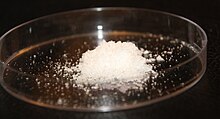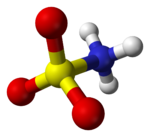Sulfamic acid

| |||
| |||

| |||
| Names | |||
|---|---|---|---|
| IUPAC name
Sulfamic acid
| |||
| Identifiers | |||
3D model (
JSmol ) |
|||
| ChEBI | |||
| ChEMBL | |||
| ChemSpider | |||
ECHA InfoCard
|
100.023.835 | ||
| EC Number |
| ||
| 25628 | |||
PubChem CID
|
|||
RTECS number
|
| ||
| UNII | |||
| UN number | 2967 | ||
CompTox Dashboard (EPA)
|
|||
| |||
| |||
| Properties | |||
| H3NSO3 | |||
| Molar mass | 97.10 g/mol | ||
| Appearance | white crystals | ||
| Density | 2.15 g/cm3 | ||
| Melting point | 205 °C (401 °F; 478 K) decomposes | ||
| Moderate, with slow hydrolysis | |||
| Solubility | |||
| Acidity (pKa) | 1.0[1] | ||
| Hazards | |||
| GHS labelling: | |||

| |||
| Warning | |||
| H315, H319, H412 | |||
| P264, P273, P280, P302+P352, P305+P351+P338, P321, P332+P313, P337+P313, P362, P501 | |||
| Safety data sheet (SDS) | ICSC 0328 | ||
| Related compounds | |||
Other cations
|
Ammonium sulfamate | ||
Except where otherwise noted, data are given for materials in their standard state (at 25 °C [77 °F], 100 kPa).
| |||
Sulfamic acid, also known as amidosulfonic acid, amidosulfuric acid, aminosulfonic acid, sulphamic acid and sulfamidic acid, is a molecular compound with the formula H3NSO3. This colourless, water-soluble compound finds many applications. Sulfamic acid melts at 205 °C before decomposing at higher temperatures to water, sulfur trioxide, sulfur dioxide and nitrogen.[2]
Sulfamic acid (H3NSO3) may be considered an intermediate compound between
Production
Sulfamic acid is produced industrially by treating urea with a mixture of sulfur trioxide and sulfuric acid (or oleum). The conversion is conducted in two stages, the first being sulfamation:
- OC(NH2)2 + SO3 → OC(NH2)(NHSO3H)
- OC(NH2)(NHSO3H) + H2SO4 → CO2 + 2 H3NSO3
In this way, approximately 96,000 tonnes were produced in 1995.[3]
Structure and reactivity

The compound is well described by the formula H3NSO3, not the
Hydrolysis
The crystalline solid is indefinitely stable under ordinary storage conditions, however, aqueous solutions of sulfamic acid slowly hydrolyse to ammonium bisulfate, according to the following reaction:
- H3NSO3 + H2O → [NH4]+[HSO4]−
Its behaviour resembles that of
Acid–base reactions
Sulfamic acid is a moderately strong acid, Ka = 0.101 (pKa = 0.995). Because the solid is not
- H3NSO3 + NaOH → NaH2NSO3 + H2O
Double deprotonation can be effected in liquid ammonia to give the anion HNSO2−
3.[6]
- H3NSO3 + 2 NH3 → HNSO2−
3 + 2 NH+
4
Reaction with nitric and nitrous acids
With nitrous acid, sulfamic acid reacts to give nitrogen:
- HNO2 + H3NSO3 → H2SO4 + N2 + H2O
while with concentrated nitric acid, it affords nitrous oxide:[7]
- HNO3 + H3NSO3 → H2SO4 + N2O + H2O
Reaction with hypochlorite
The reaction of excess hypochlorite ions with sulfamic acid or a sulfamate salt gives rise reversibly to both N-chlorosulfamate and N,N-dichlorosulfamate ions.[8][9][10]
- HClO + H2NSO3H → ClNHSO3H + H2O
- HClO + ClNHSO3H ⇌ Cl2NSO3H + H2O
Consequently, sulfamic acid is used as hypochlorite
Reaction with alcohols
Upon heating sulfamic acid will react with alcohols to form the corresponding
- ROH + H2NSO3H → ROS(O)2O− + NH+
4
An example of this reaction is the production 2-ethylhexyl sulfate, a wetting agent used in the
Applications
Sulfamic acid is mainly a precursor to sweet-tasting compounds. Reaction with
Sulfamates have been used in the design of many types of therapeutic agents such as
Cleaning agent
Sulfamic acid is used as an acidic
Sulfamic acid is preferable to hydrochloric acid in household use, due to its intrinsic safety. If inadvertently mixed with hypochlorite based products such as bleach, it does not form chlorine gas, whereas the most common acids would; the reaction (neutralisation) with ammonia, produces a salt, as depicted in the section above.
It also finds applications in the industrial cleaning of dairy and brewhouse equipment. Although it is considered less corrosive than hydrochloric acid, corrosion inhibitors are often added to the commercial cleansers of which it is a component. It can be used as a descalant for descaling home coffee and espresso machines and in denture cleaners.
Other uses
- esterificationprocess
- Dye and pigment manufacturing
- Herbicide
- Descalant for scale removal
- Coagulator for urea-formaldehyde resins
- Ingredient in fire extinguishing media. Sulfamic acid is the main raw material for ammonium sulfamate which is a widely used herbicide and fire retardant material for household products.
- Pulp and paper industry as a chloride stabilizer
- Synthesis of nitrous oxide by reaction with nitric acid
- The deprotonated form (sulfamate) is a common counterion for nickel(II) in electroplating.
- Used to separate nitrite ions from mixture of nitrite and nitrate ions( NO3−+ NO2−) during qualitative analysis of nitrate by Brown Ring test.
- Obtaining deep eutectic solvents with urea[13]
Silver polishing
According to the label on the consumer product, the silver cleaning product TarnX contains thiourea, a detergent, and sulfamic acid.
References
- .
- ISBN 0471238961.
- ISBN 978-3527306732.
- ^ .
- .
- .
- .
- ^ US 3328294, Self, Richard W.; Watkins Jr., Joseph C. & Sullins, John K., "Process for control of micro-organisms in process streams", published 1967-06-27, assigned to Mead Corp.
- ^ FR 2087248, "Systèmes aqueux stables contenant un composé N-hydrogéné et un hypohalogénite [Stable aqueous systems containing an N-hydrogenated compound and a hypohalogenite]", published 1971-12-31, assigned to E. I. Du Pont De Nemours & Co.
- ^ ISSN 0009-2665.
- S2CID 1361433.
- ^ Benckiser, Reckitt. "Material Safety Data Sheet – Lime-A-Way Lime, Calcium and Rust Cleaner (Trigger Spray)" (PDF). hardwarestore.com. Archived from the original (PDF) on 17 July 2011. Retrieved 17 November 2011.
- ^ Kazachenko, Aleksandr S.; Issaoui, Noureddine; Medimagh, Mouna; Yu. Fetisova, Olga; Berezhnaya, Yaroslava D.; Elsuf'ev, Evgeniy V.; Al-Dossary, Omar M.; Wojcik, Marek J.; Xiang, Zhouyang; Bousiakou, Leda G. "Experimental and theoretical study of the sulfamic acid-urea deep eutectic solvent" (2022) Journal of Molecular Liquids, 363, art. no. 119859 DOI: 10.1016/j.molliq.2022.119859
Further reading
- "Chemical Sampling Information – Sulfamic Acid". Occupational Health & Safety Administration. 6 May 1997. Retrieved 17 November 2011.
- Cremlyn, R. J. (1996). An Introduction to Organosulfur Chemistry. Chichester: John Wiley and Sons. ISBN 978-0-471-95512-2.
- ISBN 978-0-08-037941-8.


